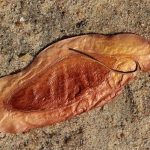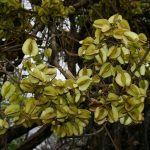TREE LIFE
March 1998
The annual subs ($60) are due again. Please use the Invoice attached to your February Tree Life when paying and Indicate If your address has changed.
Stop Press! (i) Anthon Ellert, Chairman of the Bulawayo Branch is planning a trip to the botanically exciting Buchwa Mountain in August. This entails advance planning so if you think you would like to be on that trip please contact Anthon in Bulawayo at home on 46586 or during office hours on 540581 as soon as possible so that an assessment of the size of the group can be made and plans set in motion.
Stop Press (ii) a visit to Chipinge is planned over the Easter Weekend, which is from April 10-13. Accommodation for 15/20 people will probably be in dormitories, on a tea estate (or own tents) and we must bring everything – beds, bedding, food and drinks. If you are interested please phone Maureen Silva-Jones in Harare at home on 740479 or during office hours on 755750.
We record with regret the death on 8 February 1998 of Mr. Richard ‘Dick’ Petheram who was for many years a committee member and Trustee of the Society. In due course we hope to publish a full obituary.
MASHONALAND CALENDAR
Tuesday 3rd March. Botanic Garden Walk. This month Tom continues the series on some of the lowveld trees. We will meet Tom in the car park at 4.45 for 5.00 p.m. and there will be a guard for the cars.
Sunday 15th March Frank and Pam Wilson of Burnside Farm in the Pote Valley are our hosts once again. This time they wish to show us a different vegetation type on the farm. We will meet at the homestead at 9.30 a.m. Keep a look out for Tree Soc. signs..
Saturday 28th March. Mark’s Walk will be on a property owned by Arthur and Sylvia Dunkley, and promises to be a venue with plenty of interest. There will be Tree Soc. signs.
Tuesday 7th April. Botanic Garden Walk.
MATABELELAND CALENDAR
Wednesday 4th March. On the first Wednesday of each month an episode of the wonderful video The Private Life of Plants will be shown at Girls’ College at 7.30 for 8 p.m. The episodes have enchanting titles such as: Travelling; Growing; Flowering; Social Struggle; Living Together; and Surviving.
Sunday March 1st.Visit to Chipangali where we have been invited to assist in the development of an indigenous tree woodlot. Meet in the car park at Girls’ College for a prompt 8.30 departure.
GEOFFREY ARCHER
It is with deep sorrow that we announce the passing of Geoff on 26 January 1998.
He was one of our longstanding members and will be remembered by all of us in Matabeleland for his profound knowledge of trees. He was also an amateur astronomer, ornithologist and geologist. He was a regular walker in the Matopos Hills and his intimate knowledge of this area, its geography, history and rock art is well known.
Geoff was a quiet, unassuming man with a great sense of humour, and to many of us he was both friend and mentor. He went to spend last Christmas with his family in Chegutu district and looked forward to returning to Bulawayo in time for New Year when he was to have taken some friends around Matopos for a long walk. Sadly he became ill there at Chegutu and never recovered.
We all recall the occasion some four years ago when Geoff, who never lost his way, actually did get lost in the Matopos for a day and a night. He spent the night wedged in between the roots of a Ficus glumosa at the top of a granite kopjie. When we, his friends, finally found him the next day after a sleepless night and some hairy and long searching forays complete with helicopter, we were astonished to find him in better shape than most of us and he had the temerity to ask what all the fuss was about.
As Father Odilo said at the funeral service, “He was a shining example of a man. Always courteous, discreet, correct, obliging and even-tempered, yet very independent.”
We shall miss him.
-Clem Van Vliet.
CHRISTMAS SOCIAL – 7 DECEMBER 1997.
The Mashonaland Branch of the Tree Society held its Christmas Social and Bingo Competition at Serui Source Farm, near Norton. Thirty members gathered for tea on the verandah of Jim and Ann Sinclair, who were our hosts for the day. They live in a delightful old farmhouse dating back to the early 1930’s, red farm brick walls, pine floors, thatched roofs and rambling additions, set in a beautiful garden full of tall, old trees. We enjoyed all sorts of Christmas fare, provided by the members, including three different varieties of mince pies, my first of the festive season. Then off we drove to the next door farm, Knockmaroon, also owned by the Sinclairs, which happens to have been the original home of the Lawrence family when they came to Zimbabwe before the First World War.
We parked under the trees next to a large herd of beautiful cattle, drew our Bingo cards, and set to work under the very able leadership of Phil. You would think that it would be easy for someone to mark off all 10 trees on his card in the course of a morning’s walk, especially when you know that all the trees listed had been identified on the farm by the Society on a precious visit. But it was not to be. We started off at a leisurely pace through the woodland, marvelling at the variety of well-grown trees and shrubs that were present, casually ticking off our finds as we went. Time passed, but no one claimed a full house, or anywhere near one. We foraged into the edge of the vlei. Still no winner. Ann led us to unusual trees that she remembered. No luck. We walked faster and faster searching the undergrowth in desperation Phil started to take chances with his identification; “I think it’s Euclea natalensis. Does anyone want that one? O.K., that’s what we’ll call it!” Maureen foraged like a terrier around the pack, looking for any species that we might have missed. Finally, we decided that lunch was more important than finding the last tree on somebody’s card, so we returned to the cars and divided the prize between the three members who had managed to record nine of the trees that they required.
Besides having an entertaining competition, we also explored some very attractive woodland. The area of the walk was dominated by enormous, spreading Brachystegia spiciformis, some of the largest I have seen in Zimbabwe, and reminiscent of the tall trees we remember from Malawi. Ficus thonningii was also well represented, with some very large specimens doing their strangling act, and we came across a few big Erythrina abyssinica. One of the largest trees of all, growing on an anthill, was reputed to be a Diospyros mespiliformis, which we accepted, with some reservations, until Mark discovered that it had milky latex; that made it
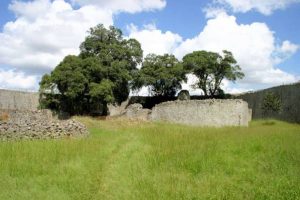
Mimusops zeyheri. Photo: M.T. Jackson. Source: Flora of Zimbabwe.
Mimusops zeyheri. Beneath the large trees there were areas of parkland, dotted with rocks and fallen trees on which we could sit to recover from our exertions in the warm, humid atmosphere, and other areas of thicket, from which we flushed occasional Francolin.
It was too late in the season for most of the flowers, and too early for most of the fruit, but we all sampled the raisin-like fruit of Carissa edulis, which was growing in profusion, and some of the braver ones tried the Ximenia caffra, more for the experience than for the pleasure; it is not called the sour plum for nothing.
There were a few late flowering Acacia spp., and we were treated to a good demonstration of the differentiation of Acacia karroo and Acacia rehmanniana by their flowers; a specimen of each stood side by side, both with straight thorns and reddish bark. Acacia karroo with yellow flowers and Acacia rehmanniana with white.
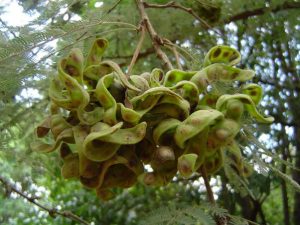
Dichrostachys cinerea. Photo: Bart Wursten. Source: Flora of Zimbabwe.
Dichrostachys cinerea was also in flower, with its pink and yellow Chinese lanterns, while a few late Peltophorum africanum displayed their abundant yellow sprays.
After lunch, accompanied by chocolates provided by our Chairman, we returned to the house and strolled around the garden admiring, and sometimes puzzling over, Ann’s collection of indigenous and exotic trees and shrubs. Another very welcome cup of tea, the last of the mince pies, a quick tour of the commercial Protea nursery, and back we went to the city to relax after another enjoyable day in the country. Thank you, Ann and Jim, for your hospitality.
-John Lawrence.
BOTANIC GARDEN WALK: 3 February 1998
Tuesday afternoon was bright and sunny after a week of rain, and with Tom’s guidance we continued with lowveld trees. As we covered quite a number of species it might be worth looking back on your March and October 1996 issues of Tree Life for some of the species that are not included here.
Starting with the larger trees that are lowveld inhabitants, one of the commonest is, the wing pod, Xeroderris stuhlimanni, which is found mainly on sandy soils in a variety of habitats. A pale grey sometimes-nondescript bark will produce a red sap when slashed, similar to that of the Pterocarpus species. The leaves are compound with a distinct twist to the terminal leaflet.
Kirkia acuminata is also extremely widespread and takes its common name of White Syringa from the long lasting remains of the inflorescences that stay on the tree for many months. A compound leaf with narrow leaflets gives the tree a slightly feathery appearance.
Berchemia discolor the bird plum is a constituent of dry forest and Jesse. The leaves have remarkably even venation and purple petioles when young and the bark is of an uneven rough texture. It is a useful and attractive tree but unfortunately is rather slow growing, the growth rate in the gardens being about 5 meters in 25 years.
The Wooden banana, Entandrophragma caudatum has an unusual fruit where the outer woody bracts partly peel away from the core. The leaflets are opposite and an important feature to note is the long petiole and very long attenuate tip. The timber is prized for furniture use, which is leading to widespread exploitation.
Well known in low to medium altitudes is the Marula – Sclerocarya birrea, which is characterised by the ‘square’ darker patches on the grey bark. A compound leaf is produced with a distinctive bluish-green colour and each leaflet has a long petiole.
Two of the typically lowveld Albizia with flat crowns included Albizia anthelmintica which has a bipinnate leaf with larger leaflets compared with Albizia zimmermannii which looks more like the widely cultivated Albizia gummifera and is restricted to low altitude country in the north, so it should be possible to separate the species using a geographical basis.
To the smaller trees encountered in the lowveld and a look at Karomia tettensis (was Holmskioldia) which has the curious common name of wild Chinese hats. An elliptic shaped leaf is noticeable with the upper part being coarsely toothed and both surfaces covered with fine hairs. This species is restricted to Zambezi valley.
The Commiphora species covered included Commiphora ugogensis, which has an olive green trunk with a pale brown peeling bark and branches with a definite zigzag pattern armed with single spikes and Commiphora karibensis which is a common component in jesse and low altitude woodland and has a smooth very dark grey bark with highly fluted branches and trunk. The specific names applied to these trees refer to the geographical location of the original specimen, the Kariba gorge for the latter and a locality in Tanzania for the first. With most of the Commiphora species the soft resinous wood is attractive to browsing elephants in need of a tasty snack.
The wooden pear, Schrebera trichoclada is some¬times a little difficult to identify but the following features may be of use: the dull green leaves are opposite and decussate, with obvious venation on the underside. However, if a small split pear like fruit is around then the answer is certain.
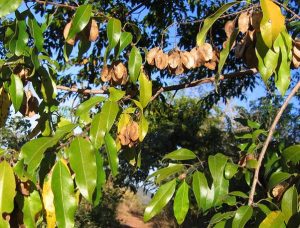
Pteleopsis myrtifolia. Photo: S.Dondeyne. Source: Flora of Zimbabwe
Pteleopsis myrtifolia produces a 2-winged fruit that lends itself to being often called a false Combretum. A feature mentioned by Tom is the very droopy nature of the young branches and twigs and may provide some guide, while the leaves are opposite and simple. This particular species occurs in both Limpopo and Zambezi basins and occurs in a wide variety of habits while Pteleopsis anisoptera occurs to the north of main watershed only and produces a 4- (sometimes 5- ) winged fruit.
A very common component of Zambezi valley vegetation is Combretum elaeagnoides and is often found along watercourses. A distinctive opposite leaf is produced which has a wavy margin and a grooved midrib. The leaf surface as with most Combretum is covered with a mass of tiny silvery scales.
Excoecaria bussei produces a large pale green 3-lobed fruit somewhat triangular in shape and being Euphorbiaceae the spherical seeds contained within the lobed fruit should not be eaten. The leaves are alternate and are highly serrated with a pointed tip, while a milky sap is also present. Typical habitats include stream banks and dry forest.
Another species with large opposite leaves and a white sap is Holarrhena pubescens, which belongs to the Apocynaceae family. White flowers are produced in heads near a leaf axil and have a jasmine-like scent, while the rough bark seems to be used traditionally for fever treatments.
Pavetta cataractarum looks somewhat like the more familiar Pavetta schumanniana, but the bacterial nodules appear raised and form small ‘bumps’ on the leaf surface. Clusters of white flowers with exerted anthers are produced on the terminal ends of branches making this species very attractive when in flower.
Finally one of the unusual trees discussed was Sterculia appendiculata, which has a restricted range near where the Mazowe River enters Mozambique. It differs from the better-known Sterculia species in that the tall straight trunk is a pale yellow to green colour and the leaves are much smaller but have 5 conspicuous lobes.
Thank you Tom for once again taking us around and we look forward to our next Botanic walk.
Andy MacNaughtan
MTEPATEPA – 18 JANUARY 1998
This is the third, if not fourth, time that the society has been to the Cottrill’s at Guitingwood and it remains a popular venue especially with John’s expanding arboretum and their hospitality. As always Lilian’s scones and tea made a most welcome start to the day but by 10 a.m. it was already unpleasantly hot so the larger than usual party followed John to the cool shady canopy of the arboretum, our numbers swelled by the welcome arrival of members from the Aloe Society.
We’ve covered this area several times yet there is always something new to discuss and on the fringe of the kopjie close to some cow stalls are a couple of planted Jatropha curcas which is often found around areas of human habitation and is often an indicator of abandoned sites. Michael Gelfand’s work revealed that the oil extracted by pounding the seeds is frequently used for treating various skin complaints but as it belongs to the Euphorbiaceae family, the seeds are poisonous if ingested. However the seeds have considerable potential for specialised oil production. Another tree with fairly widespread uses is Pericopsis angolensis where the bark and roots find use for a variety of ailments and it would appear that the goats know a thing of two about self medication as the lower portion of all these trees have had their bark shredded by these creatures. The timber, although prized is hard to work and heavy and most trees in this country are really too small to be of major commercial value.
Within the kopjie itself was a tall erect Dovyalis zeyheri – wild apricot, it is reasonably easy to identify as it has bright green leaves complete with leaf miner ‘ race tracks ‘. Dovyalis caffra is a near relative and is well known as the Kei apple for those familiar with the Eastern Cape. From the “The Diary of Iris Vaughan” comes this bit,
“Round the Church is a green hedge with large lovely cherries on it, Gladys Long said they are Kei apples are not poison. I said is it allowed for us to pick them. She said yes but no one likes to eat them. I et 1 and Charles et 3 and then we went into Sunday school…. I wanted to tell them that I knew about Moses and Aaron and Solomon but I got a sudden awful sick feeling in my stummick and knew I was going to vomit. Charles also had the feeling. I just pushed quickly over Gladys and ran out. Miss Jolly tried to stop me, but I ducked. Charles and l got out together. It was the Ky apples.”
We also found Catha edulis, the specific name of this tree means edible and probably refer to the Qat of the Middle East or Merah in East Africa. A chewed leaf placed under the tongue is supposed to have a narcotic effect and as on this occasion I had friends to drive me home I had a really good chew (at John’s prompting) and about 30 minutes later an unusual headache began to pound at the top of my head, but the astringent nature of the chewed leaf would put you off any supposed narcotic bliss.
In the midst of digging a hole for an Albizia gummifera, some relics of iron age activity were unearthed, a shallow circular depression lined with narrow bricks formed a hearth with the remains of a tuyere or blastpipe, glass hard from so many heats having sintered it plus a few lumps of slag and imported charge being banded ironstone. As most of the iron produced in this way was hand forged later the gassy state of the liquid iron did not appear to present a major problem unlike today’s iron and steel industry. A tangle of Dichrostachys cinerea also occurs here and it seems that traditional name of Mupangara refers to tassels for a chief’s hat, as well as having the common name of Chinese lanterns. Often cursed by agriculturists and farmers it is an extremely useful species, whether its use in stabilising shifting soils or in its fruit, the contorted pods being a source of protein for game and cattle. One of the curious finds of the day would be Tacca sp., a succulent textured annual with a deeply divided leaf branching in threes from a short stem. We only noticed it as the cone of orange spherical seeds occupying the top quarter of the inflorescence is REALLY distinctive. Trish Rimanek also found a similar one under the spreading Diospyros mespiliformis; this one having leaves in pairs with a swollen bladder-like fruit.
(After discussion with Mark it is believed two distinct plants were found. The one with red fruit could be Amorphophallus abyssinicus, and the one with the bladder-like fruit – Tacca sp. We would be very interested to hear if there was a positive ID from another source. Ed.)
John’s magnificent Sterculia quinquiloba is the highlight of the kopjie with its huge pale bole squeezing out of the rocks. As the tree supports a massive canopy and a few of us considered the massive forces at work in supporting the branches while waiting for the others who had ‘spaced’ out on the large flat rocks beneath. A faint vanilla-like scent wafting about indicated that the tree had started to, flower. Along the base of the boulders the higher moisture content encourages a variety of trees such as Flacourtia indica, variable as always, and Azanza garckeana, the snot apple. Each year a troop of Vervet Monkeys rush down the steep rock face and launch themselves at the ripe fruits of the aptly named monkey fingers,
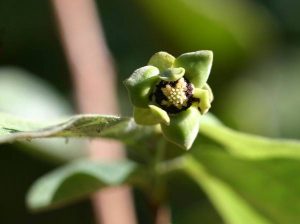
Friesodielsia obovata. Photo: Bart Wursten. Source: Flora of Zimbabwe
Friesodielsia obovata. The fruits at this stage although green have the definite finger shape and this plant belongs to Annonaceae, which includes the Custard apple. Did anybody note the Kite Spiders spinning the first threads of their webs in the foliage behind the tree? On now to some Commiphora, Commiphora mollis with a non¬descript pale grey trunk and the bright green trunk of Commiphora marlothii, which interestingly enough has no peeling bark at this time of the year – something to keep in mind for our next trip. A major factor in the seed distribution for Commiphora species is that Hornbills are attracted to the attractive red fleshy aril that encapsulates the seed when mature.
A number of figs trees follow a fracture line and as our knowledge of the fig wasp and fig cycle increases it appears that once the blind and wingless males gnaw through the tough outer skin the release of a certain amount of carbon dioxide gas from the holes seems to be the signal for the fruit to ripen. The male fig wasps, find the nearby females, mate and die – not much of a life!
A few of the other fig trees following the fissure are Ficus glumosa, the rock splitter and Ficus ingens, one particular tree of the species caused much anguish to the City Presbyterian Church staff as visiting birds and bats splattered the neatly white¬washed walls with the after effects of their feeding. One of the planted figs is Ficus bussei which is generally a Zambezi valley type, can grow to tremendous proportions, such as those at Rifa and apparently there is an enormous one in Chewore.
For a final TWEAK at our members, the confetti bush Maytenus senegalensis has a name change, it is now Gymnosporia senegalensis, sorry for that!
We had intended to have another look at Koi and water lilies but with the hot sticky afternoon most members slunk into the deep shade – the group under the Mango trees sharing accommodation with the mosquitoes. Once again our most grateful thanks to John and Lillian for a most enjoyable day and to Phil for leading an excellent walk. It was especially pleasing to have so many Aloe Society members joining us.
Andy MacNaughtan
ANDY MACNAUGHTAN CHAIRMAN


